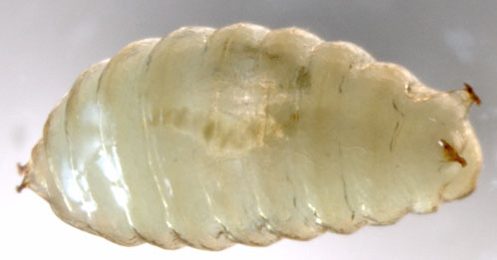|
||||||
|
Phytomyza
ranunculivora Hering, 1932 Phytomyza
ranunculivora Hering, 1932a. Z. wiss. InsektBiol. 26:
160 |
||||||||||||||||||||||||||||||||||||||||||||||||||||||||||||||||||||||||||||||||||||||||||||||||||||
|
Leaf-miner: Long, upper-surface corridor with the frass in relatively large, widely dispersed fragments. Pupation outside the mine; exit slit in lower epidermis (Bladmineerders van Europa). Forms an elongated linear mine with the frass grains are widely spaced, which enables distinction between this species and P.ranunculi, where the frass is in closely adjoining grains. Pupation is external (British leafminers). Larva: The larvae of flies are leg-less maggots without a head capsule (see examples). They never have thoracic or abdominal legs. They do not have chewing mouthparts, although they do have a characteristic cephalo-pharyngeal skeleton (see examples), usually visible internally through the body wall. The larva is described by de Meijere (1938a) (Bladmineerders van Europa). Puparium: The puparia of flies are formed within the hardened last larval skin or puparium and as a result sheaths enclosing head appendages, wings and legs are not visible externally (see examples). Yellow; posterior spiracles each with 12 well-defined bulbs, forming an almost complete circle (Spencer, 1976: 483 (fig. 488B)). Orange-yellow (British leafminers).
Comments: Ranunculus ficaria is treated as Ficaria verna (Lesser Celandine) by Stace (2010). Hosts in Great Britain and Ireland:
Hosts elsewhere:
Time of year - mines: July-August, October. Time of year - adults: May the following year. Distribution in Great Britain and Ireland: Widespread in Britain including Surrey (Chipsetad), Middlesex (Mill Hill), Pembs (Tenby) (Spencer, 1972b: 90), Mid Perth (Balrobbie Farm) (Bland, 1994c: 83), Warwickshire (Kingsbury Wood) (Robbins, 1991: 27); Anglesey, Cumberland, Leicestershire, Main Argyll, Mid-west Yorkshire, Shropshire, South Somerset and South-west Yorkshire (NBN Atlas). Also recorded in Northen Ireland. See National Biodiversity Data Centre Map). Distribution elsewhere: Widespread in continental Europe including Denmark, Finland, Norway, Sweden, Spain (Menorca) (Spencer, 1976: 484), The Netherlands, Luxembourg (Bladmineerders van Europa), Germany (Spencer, 1976: 484), Austria, Balearic Is., Belarus, Czech Republic, Estonia, Italian mainland, Lithuania, Poland and Slovakia (Fauna Europaea). NBN Atlas links to known host species:
British and Irish Parasitoids in Britain and elsewhere: Currently unknown. |
| Last updated 06-Dec-2017 Brian Pitkin | ||

